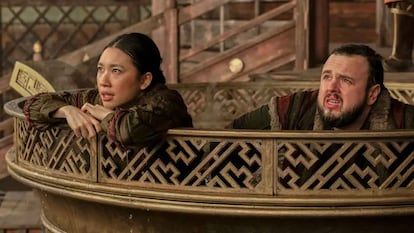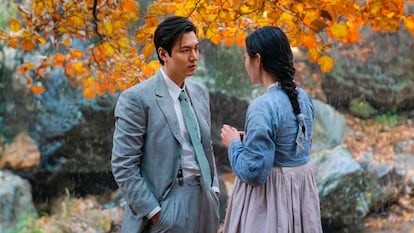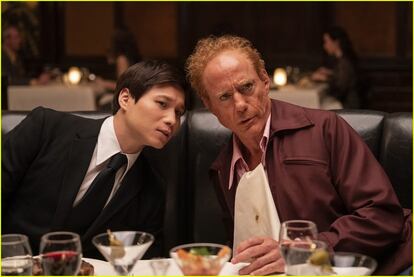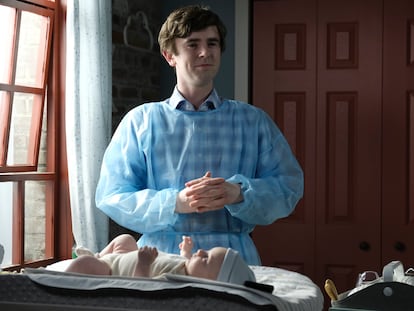From ‘Shōgun’ to ‘3 Body Problem’: Are we going too far with the Westernization of Asian stories?
Streaming platforms are seeking out hybrid plots to conquer both major world markets, productions tailor-made for viewers who are unafraid of the ‘one-inch-tall barrier’ of subtitles


The transition from Asian to Western content is becoming more and more common on streaming platforms forever seeking to conquer global audiences. After Money Heist’s worldwide success, Netflix produced a Korean version of the series. The South Korean Squid Game morphed into the tale of a U.S. contest that recreated the original series’ challenges. The cultural industry is starting to bet more and more on hybrid content, occasionally based on books, with the goal of seducing both markets. Such has been the case of series like Shōgun (now available on Disney+ ), The Sympathizer, Tokyo Vice (both available on HBO Max) and Pachinko (Apple TV+).
“A good culture clash is always juicy for scriptwriters, because it generates conflict and enriches plots,” Lorenzo Mejino, an expert in international series and co-author along with Paula Hergar of the book La vuelta al mundo en 80 series (Around the world in 80 series), tells EL PAÍS by telephone.

Japanese publicity agency Dentsu carried out a survey in July 2022 that analyzed the popularity of anime and the characteristics associated with its consumption in the United States, focusing on 18 to 54-year-olds, advertisers’ most-valued age group. The result showed that the genre has particularly enamored Generation Z (those under the age of 25), 44% of whom, equal to 19 million viewers, watch the most viral anime programs.
The number of U.S. residents who watch Korean dramas, called k-dramas, is similar: 18 million, the majority of them young people, according to Korea Creative Content Agency (KOCCA). That’s why, in addition to creating live-action versions of shows like One Piece and Cowboy Bebop, practically every on-demand content service out there has its own original series that combines the two cultures. They’re especially intent on attracting young people, who aren’t as hemmed in by cultural barriers as pre-internet generations. Younger people have no problem in leaping over the “one-inch-tall barrier of subtitles,” as Bong Joon-ho, the director of Parasite, put it upon receiving his unprecedented Golden Globe and Oscar for Korean cinema in 2020.
In many cases, original Asian material is adapted for a Western audience. Star Chinese science-fiction author Liu Cixin sold the rights to her novel The Three-Body Problem twice, says Mejino. The first time, producers created a Chinese version that was as extensive and baroque as her original text, with more than 30 episodes with durations of more than 40 minutes. Netflix then paid her to make their English-language adaption, enlisting the efforts of the creators of Game of Thrones. Currently, the production consists of an eight-episode season that condenses characters and shifts the action from Asia to a very British Oxford. Even U.K. television, specifically ITV, has turned to bestselling Japanese author Hideo Yokoyama to turn one his mystery novels, Six Four, which follows the kidnapping of a little girl in northern Tokyo, into a series that moves the location to the United Kingdom.

Several other projects have arrived on screens more organically, through a simple demographic shift: there are more and more U.S. residents with Asian heritage in leadership positions in Hollywood and other cultural industries. Such is the case of Soo Hugh, the showrunner of Pachinko, which is waiting to begin its second season. The series hails from South Korean and Canadian television, and focuses on four generations of a Korean family in Japan and the United States, adapted from the 2017 novel of the same name written by Korean-American author Min Jin Lee.
Despite a vast increase in U.S. content focusing on characters and stories connected to Asia and the Pacific islands — in the last 15 years, they’ve gone from 3% of characters to 16%, according to the University of Southern California — more than 70% of viewers with heritage from those countries are unsatisfied with the authenticity of their representation in television and film, according to figures from the non-profit organization Gold House and McKinsey & Co. consultants.

Park Chan-wook is part of the team behind The Sympathizer, based on the Nobel Prize-winning novel by Vietnamese-American writer Viet Thanh Nguyen. The thriller’s main character is a communist French-Vietnamese spy during the last days of the Vietnam War and his subsequent exile in the United States, with Hoa Xuande playing the lead role and Sandra Oh and Robert Downey Jr. as supporting characters. Warner’s streaming platform has already launched the second season of Tokyo Vice. Its story of a U.S. man persecuted by the yakuza in the Japanese capital is based on the book of the same name by Jake Adelstein, the first Western journalist to work at Japanese newspaper Yomiuri Shimbun. The series depicts the various challenges of a Japanese society intent on ignoring its organized crime problem.
In the world of academic research, the term “Westernize” has a derogatory component that designates the countries of the West “as first world, as compared to those of the East, which are nearly considered the third world,” says Sonia Dueñas, a researcher at Madrid’s Universidad Carlos III.
Belgian history professor Frederick Cryns is well aware of this legacy. He has lived in Japan for decades, works at Kyoto’s International Research Center for Japanese Studies, and consulted for Disney+ on Shōgun, which was executive-produced by Rachel Kondo, a Japanese-American. The James Clavell novel, set during the arrival of the first Europeans to feudal Japan, was adapted in the 1980s for a version starring Richard Chamberlain. “For us it was important, in contrast to the first series, that this time, the Japanese point of view carry the same weight as the Western one,” Cryns explained to this publication at the beginning of March, when the remake premiered.

Sign up for our weekly newsletter to get more English-language news coverage from EL PAÍS USA Edition
Tu suscripción se está usando en otro dispositivo
¿Quieres añadir otro usuario a tu suscripción?
Si continúas leyendo en este dispositivo, no se podrá leer en el otro.
FlechaTu suscripción se está usando en otro dispositivo y solo puedes acceder a EL PAÍS desde un dispositivo a la vez.
Si quieres compartir tu cuenta, cambia tu suscripción a la modalidad Premium, así podrás añadir otro usuario. Cada uno accederá con su propia cuenta de email, lo que os permitirá personalizar vuestra experiencia en EL PAÍS.
¿Tienes una suscripción de empresa? Accede aquí para contratar más cuentas.
En el caso de no saber quién está usando tu cuenta, te recomendamos cambiar tu contraseña aquí.
Si decides continuar compartiendo tu cuenta, este mensaje se mostrará en tu dispositivo y en el de la otra persona que está usando tu cuenta de forma indefinida, afectando a tu experiencia de lectura. Puedes consultar aquí los términos y condiciones de la suscripción digital.
More information
Archived In
Últimas noticias
Trump claims peace in Ukraine is near, but Moscow suggests otherwise
A survivor’s account of the Interoceanic Train accident: ‘We were scared because of the speed on the curve’
The Interoceanic Train, the Mexican alternative to the Panama Canal
What is known about the Interoceanic Train derailment in Oaxaca
Most viewed
- Oona Chaplin: ‘I told James Cameron that I was living in a treehouse and starting a permaculture project with a friend’
- Reinhard Genzel, Nobel laureate in physics: ‘One-minute videos will never give you the truth’
- Why the price of coffee has skyrocketed: from Brazilian plantations to specialty coffee houses
- Pablo Escobar’s hippos: A serious environmental problem, 40 years on
- Chevy Chase, the beloved comedian who was a monster off camera: ‘Not everyone hated him, just the people who’ve worked with him’










































